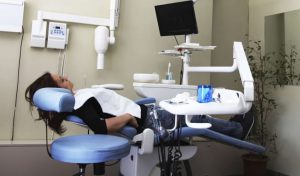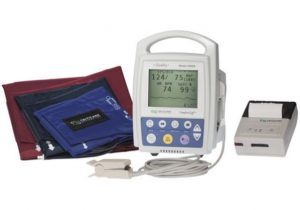Sedation dentistry is any treatment aimed at reducing anxiety during dental treatment. The most common sedation solutions involve the use of drugs to put you at ease. Your dentist will use different medications to place you into a semi-conscious or unconscious state. Now your dentist can perform your treatment without your anxiety getting in the way. There are plenty of benefits to sedation dentistry for those who are deadly afraid of the dentist. For example, your dentist can perform extensive dental work while you are under sedation. Additionally, you will feel little to no discomfort and won't remember much of anything afterward. Sedation dentistry is particularly helpful for complex dental treatment as well as surgical procedures. There are a few different common sedation techniques which include Nitrous Oxide, oral conscious sedation, IV sedation, and general anesthesia.

The goal of sedation dentistry is to ease your fear and anxiety at the dentist
Should I consider going to sleep for my dental treatment?
This is a personal decision ultimately. Most people do not require sedation for their treatment. In fact, the vast majority of patients do fine without any sort of sedation. However, there are patients who are great candidates for sedation dentistry. There are also treatments where sedation is a must. It all depends on which treatment you require and how afraid of the dentist you are. Here are examples of scenarios that make for good candidates for sedation dentistry:

Sedation dentistry is ideal for those with extreme dental phobia, wisdom tooth extractions, and other complex dental treatments
Extreme Dental Phobia
This is for those of you who are so afraid of the dentist that you simply refuse to see one. If that's the case, then sedation is probably your one and only option. Schedule a consultation with a dentist who offers sedation dentistry to come up with a plan to concur your fear using sedation.
Wisdom Tooth Extraction
You may not be afraid of the dentist, but we still recommend sedation if you are planning on removing all four of your wisdom teeth. Sedation dentistry is very helpful for difficult tooth extraction surgeries. Removing all of your wisdom teeth is a traumatic experience if you're awake but it's usually a breeze once you're sedated.
Extensive Dental Work
Sedation dentistry is extremely helpful if you need a ton of dental work. Here are some cases that are ideal for sedation treatment:
- Full mouth rehabilitation,
- All-on-four implants
- Removing wisdom teeth
- Removing multiple teeth
- Placing multiple dental implants combined with tooth extractions
We highly recommend that you consider sedation if you need extensive dental work involving surgical procedures. Your dentist can complete the vast majority of your treatment during a single sedation session. Keep in mind, additional follow-up visits are almost always required to finish the work. However, these are all relatively easy and painless appointments. The complicated stuff, such as removing your bad teeth, placing implant posts, opening up the gum tissue, etc. can all be performed together during a single sedation appointment.
Ultimately it's your choice as to whether or not to get sedated. There are some people who choose to stay awake when removing all of their teeth or receiving a handful of dental implants. Others choose to get sedated for a simple procedure like a crown or deep cleaning. Talk to your dentist to see what is the best route to take to fix your mouth.
What are my different sedation options?
There are a few different options when it comes to dentistry. Each option has its own implications. Here are the four most common types of sedation techniques you will come across at the dentist:
- Nitrous Oxide sedation
- Oral conscious sedation
- IV sedation
- General anesthesia
Nitrous Oxide is a gas that you inhale to calm your nerves. This is the ideal solution for patients with low levels of anxiety as well as for simple procedures like fillings, crowns, and root canals. The next level up oral conscious sedation and IV sedation. These are even more effective sedation techniques that completely knock you out. Oral conscious and IV sedation work great for more complex surgical procedures. They are also a great option for treatments that are expected to take a few hours to complete. Finally, there is general anesthesia which offers the highest level of sedation. General anesthesia is complex, costly, and requires an anesthesiologist to be present. As such, general anesthesia is reserved for only the most complex dental treatments. Regardless of the type of sedation that you choose, the goal is to complete as much dental treatment as possible during a single sedation session.

Common sedation dentistry options include Nitrous Oxide, oral conscious sedation, IV sedation, and general anesthesia
The most common sedation techniques are oral conscious sedation and IV sedation. Let's take a look at some of the benefits of these sedation methods:
Moderate-to-Deep sedation
Both oral conscious and IV sedation place you into a deep state of sleep. These sedation techniques are very effective at helping you relax and sleep while undergoing extensive dental treatment.
Ease of Administration
Oral conscious and IV sedation are simple outpatient procedures performed routinely in many dental offices. There's no need for extensive preparation before your treatment. There is also no need for an anesthesiologist and a licensed dentist can monitor you while administering the treatment. Lastly, there is no need to perform any allergy tests in advance. These sedation techniques require nothing more than taking some anxiety medications on the day of your treatment. The only thing to keep in mind is that you will be out of it for the better part of one day. As such, you must arrange for a ride back and forth to your appointment.

Oral conscious and IV sedation require minimal workup and no anesthesiologist
Safety
Going under general anesthesia is the most effective sedation technique. However, general anesthesia is far riskier than these oral conscious and IV sedation. This is because your breathing is suppressed during general anesthesia which may have fatal consequences in rare cases. With oral and IV sedation, your breathing is not suppressed and you continue breathing on your own throughout the appointment. This is another reason why general anesthesia is not as popular as oral conscious or IV sedation for most dental treatments.
What is a typical oral or IV sedation appointment like?
Most sedation sessions last anywhere from two to four hours, sometimes even longer. We recommend that you schedule your sedation session in the early morning hours when possible. Note that you won't be able to function properly for the rest of the day due to the side effects of these medications. Plan on taking the rest of the day off and getting plenty of rest afterward. The best thing is to sleep with two or three pillows under your head after you get home. Here is a preview of what a typical sedation dentistry appointment looks like:
Consultation/ Workup
All sedation appointments start off with a consultation followed by a workup appointment. During your consultation, your dentist will take X-rays, examine your teeth and come up with a treatment plan. They will go over the sedation protocol. Everything that your dentist needs, including X-rays, study models, CT scans, consent forms, and payment arrangements, are all taken care of during these appointments. On the day of the surgery, you can't engage in any meaningful conversation or give informed consent. Therefore, the entire workup needs to be completed in advance of your sedation appointment. Your dentist may prescribe medications that you must take on the day of the surgery. Be sure to take the medications as instructed. You do not need to fast for oral conscious or IV sedation. We suggest that you eat a light meal beforehand. Something like toast and apple juice or cereal. Avoid coffee, which is a stimulant. Use the restroom prior to your visit so that you don't have to worry about it during your long treatment!
Arrive at Your Appointment Early
You must arrange for reliable transportation on the day of the surgery. Choose a family member or a good friend who can be responsible for bringing you back and forth to your sedation appointment. Uber, Lyft, and Yellowcab are NOT acceptable moods of transportation for sedation dentistry. Your companion is going to be responsible for caring for you for the remainder of the day.
Relax!
You will be promptly seated in the treatment chair once you arrive at your sedation appointment. Your dentist will hook you up to a pulse oximeter device that will constantly monitor your vitals. From this point on, you can relax while your dentist fixes up your mouth. Most sedation appointments take several hours, but you'll be unaware of this since you're sedated. Once your treatment is complete, the team will contact your companion to pick you up and take you home.
Go Home & Sleep
Most patients will fall asleep as soon as they arrive home. You won't recall much of anything after sedation treatment. Be sure to get plenty of rest. Use two or three pillows to sleep with your head elevated in order to breathe better. The effects of sedation typically wear off within a few hours. You'll be back to normal by the next day at the latest. You're free to resume normal activities 24 hours after your sedation appointment.